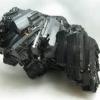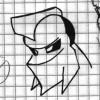
SixFootBlue
Members-
Posts
23 -
Joined
-
Last visited
Other groups
Year 08


Recent Profile Visitors
715 profile views
SixFootBlue's Achievements

Tohunga (3/293)
-
I'm in awe at how well they recreated as much detail as possible from the original commercial. From the atmosphere to the pacing to the lighting. Everything. Wow.
-
I just noticed the post updated with some up-close photos of the new bionicle sets. It looks like the beasts and umarak all come with a toa head in trans-neon green Though from the looks of it, it also seems the jaw pieces are attached to the axle hole meant for connecting the toa brain to the head... Would that mean they don't come with toa brains, and rely on the entire head for eye colour? I mean if they did come with a toa brain, then the mask would pop off every time you closed the jaw, which feels like an odd mechanic. Also lava beast is the only one to have a gear function at the waist apparently?
-
Don't think he ever posted a tutorial on it but I saw a comment posted on one of the photos saying the process involved soaking the mask in a special dye and then baking it in order to bond the dye permanently. Could try googling stuff along those lines. Granted it won't be specifically about dyeing masks, but you should be able to find tips on how to dye clear plastic and bake it without it melting.
-
I found a local store that sells it. It's Alumilite Quick-Set RTV Silicone Rubber. You can order it online from their site if you can't find it locally. There's also another silicone formula they sell that I think you can find at a Michael's art store, for about the same price, but it's softer. I don't really recommend using silicone caulk. I've tried it out a few times with mold making and find that it tends to react chemically with urethane resins (you get a ton of super tiny bubbles just coating the surface of your piece). Epoxies don't seem to react with it though.
-
Smooth-on was the first site that I was referred to when researching materials for casting, and they've got quite a nice selection! Unfortunately I live in Canada, so shipping up here gets to be pretty expensive on top of the cost of the materials. I get all my alumilite casting materials from a local store I found online, and they're pretty much second only to smooth-on so it does the job just fine. But hey whatever works.
-
Honestly coding-free 3D multiplayer game makers and nearly impossible to find nowadays. Though there's one suggestion I could make. This is more to just keep track or it's progress, rather than buy it straight away. http://store.steampowered.com/app/329890 MyRPG is a 3D game engine based off of Torque3D and it's designed for setting up 3D multiplayer RPG worlds without any programming required. It's still in development though, and has a few mixed reviews, so maybe best not to get it straight away. Though in the end, you'll have a lot more flexibility with picking up some programming language. If it's a bit too much for you to handle, but you think you have a solid idea for a game, and have the dedication to bring it to life, you could put a little team together to work on it. Games are difficult and time consuming to make on your own. Also for 3D modeling, I would suggest blender 3d. It's awesome. It has a slight learning curve, but the website provides excellent and easy to follow tutorials on all the basics you need for 3D modeling. You can also find tons of helpful tutorials on youtube. I've been using it for years now.
- 10 replies
-
- Game Development
- Game Engine
-
(and 2 more)
Tagged with:
-
For replicating colours, I'm not sure how accurate my answer is since I only have blue and neon green dye. Off the top of my head though. Medium Blue, Yellow, light grey, dark grey, black, white (white dye makes the plastic more opaque), and tan are likely easy to replicate, since you should be able to make them from single dye colours without having to do any colour mixing. A lot of the other colours may require subtle hints of other colours in order to get the right shade. (For example, mata blue is going to require maybe 3 parts blue dye to one part fluorescent green or a smaller part of yellow pigment.) As for masks easiest to mold... Well the silicone captures all the detail perfectly, though if you have a mask with a lot of deep pits in it, you're going to want to fill them while pouring your silicone, and fish out any trapped air with a toothpick, so you fill them completely. I've yet to try anything beyond 2001 kanohi, but perhaps masks with lots of thinner parts sticking out (ie Tahu Mistika's mask or Antroz's mask) may be a bit more challenging because you'd need to make sure the resin fills those gaps without any air gaps or bubbles. So I'd say 2001-2002 kanohi are the easiest. Also krana and kraata should be easy to mold as well. One tip I have for casting any mask is basically to do it in two steps. More often than not if you try and cast the entire mask all at once, you'll have trapped air where the mouth peg should be, even if you try to avoid it. An easy solution is to just fill the mouth peg and any surrounding depression with resin, lay it face up, and then put the other mold half on it so it takes the appropriate shape. Then once that's cured, mix up some more resin and pour it into the main mask mold, and then cast as normal. You don't need to worry too much about wastage since this process will only use like half an ounce of resin. Even less if you have mixing containers that can measure smaller amounts (My mixing cups go by 1/8th ounces so I usually just mix up a quarter ounce at a time).
-
So a couple updates. Used the last of my silicone to make a 2001 Kaukau mold. I managed to dodge the errors I made with my first mold cast. Had some issue with bubbles on this one, but I figured out how to fix it when casting the front. I've also been working on replicating some of lego's plastic colours using alumilite dyes. So far I've pretty much matched Medium Blue, and I'm close to matching mata blue. I don't have any other dyes other than fluorescent green though so I can't experiment with others just yet. I've also got some glow in the dark pigment powder coming in the mail, so that should be fun to play around with, especially when I get some clear resin. I think more often than not I'm going to stick with resin dye. It's quite a bit cheaper than using paint, especially since you don't need to buy primer, and you can have more control over the colours compared to spray paints. Though given I'm mixing quarter ounces of resin at a time, it can be a bit tough to measure out exact amounts. (I've had to work with a system of dabs or drops of dye on the tip of a toothpick, haha).
-
It looks great! Nice work :3
- 10 replies
-
- 1
-

-
Tomorrow I'm going to start work on making a mold for the 2001 kaukau mask, and eventually buy some clear resin for it, so you should be seeing more from me soon! Also the thought did cross my mind about selling masks to help pay for materials? (Silicone is kind of expensive). Problem is that would probably be illegal since these are basically bootlegs. I mean I know they aren't manufactured anymore, but I'd still be getting money from lego's IP and idk how they'd feel about that.
-
I'd probably not recommend melting down bricks, at least without using a dedicated oven for it. Melting plastic often releases fumes that can be hazardous to your health. If you're still set on it, maybe you could ask flintsmith for some advice on it. Last I remember they were casting hard plastic krana using melted down lego bricks.
-
Nah the "moustache" pattern was unintentional. Since this was my first time using liquid silicone, mistakes were made of course. Basically I cast the front part of the mask mold first. The back of the mask was filled with modeling clay, so I needed to remove the mask in order to get it out. The problem was removing the mask broke the original seal it had with the cured silicone, and thus a thin film of silicone leaked through the eyeholes when I cast the second part. There's another part like that on the top left part of the mask as well. Two ways to avoid it that come to mind are A) Carefully dig out the modeling clay without removing the mask from the mold at all. B) Cast the back part of the mold first. That way, after the seal is broken, any leakage will be behind the mask instead of in front. Basically just hide all the imperfections on the back where no one will see them. As for making custom masks, I have yet to try it, but I would consider using a platinum base silicone for making those molds. As it turns out, tin base silicone has a very very VERY small amount of shrinkage. On a single cast it's not very noticeable. Maybe some slight looseness on the mouth peg, but nothing major really. But after repeat casts of a duplicate, it's possible it could start to become a problem. According to the Alumilite brand's website, their platinum base silicone experiences zero shrinkage, so it's probably the one to use. Also, if you can, try and get as many of the pieces that you need off of bricklink or something, or try and find a resin that's rigid, durable, and not too flexible. I used polyurethane plastic for this, and although its very durable, it's a little more flexible than lego plastic. Also f it's exposed to higher temperatures, it becomes much more flexible and there's a possibility the shape can warp. I'm only planning on using this method for casting masks, and some other simple parts, mainly to get them in colours they were never manufactured in, or colours that are tough to get. It's not the best method for casting an entire bionicle figure. Best of luck to you. :3
-
So I also found that urethane masks are pretty easy to spray paint. No primers or surface sanding required. :3 Have a random ta matoran.


.thumb.jpg.95cf157d39cc8e3700bbe13139ae5c5b.jpg)
